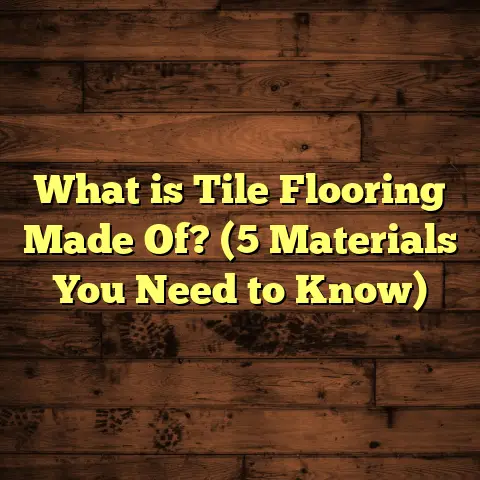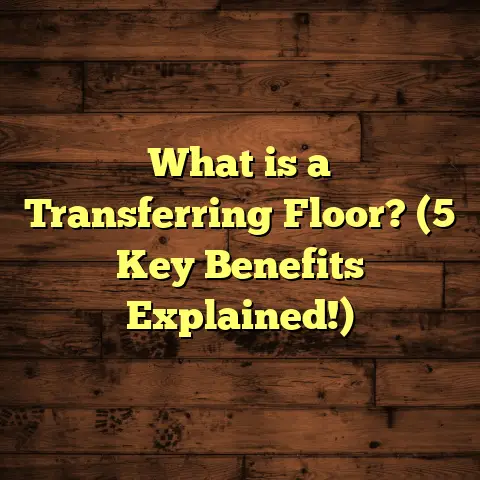What Is Lifeproof Vinyl Flooring Made Of? (5 Key Components)
When I first worked with Lifeproof vinyl flooring, I made a mistake that many people do—I assumed all vinyl floors were basically the same. I thought it was just a cheap alternative to hardwood or tile, something that didn’t require much thought beyond price. But after installing several Lifeproof floors and seeing how different they were from other vinyl options, I realized how wrong I was. This product has layers of complexity and engineering behind it that most people don’t realize. So if you’ve ever asked yourself “What is Lifeproof vinyl flooring made of?” or wondered why it’s so popular, stick with me. I’m going to break down the five key components that make this flooring so unique and reliable, sharing my own experiences along the way.
What Is Lifeproof Vinyl Flooring Made Of?
Lifeproof vinyl flooring is a type of luxury vinyl plank (LVP) or tile that is designed to mimic the look of natural materials like wood and stone while offering superior durability and water resistance. But it’s not just a single material; it’s a carefully engineered composite made up of several layers. Each layer has a specific role in providing strength, beauty, comfort, and protection.
The five key components are:
- Wear Layer
- Print Film Layer
- Vinyl Core Layer
- Backing Layer
- Protective Coatings
Each one contributes to the flooring’s overall performance. Let me explain what each layer does and why it’s important.
1. Wear Layer: The First Line of Defense
The wear layer is the topmost transparent coating of the flooring. It protects everything underneath from scratches, stains, scuffs, and everyday wear.
When I first started installing vinyl floors years ago, I used to overlook the wear layer thickness. But after seeing clients’ floors scratch or dull quickly, I learned to always check this detail carefully. Lifeproof offers wear layers generally ranging from 6 mil (thousandths of an inch) up to about 20 mil on some premium models.
Why does this matter? A thicker wear layer means better protection and longer life. For example, a 12 mil wear layer can withstand moderate household traffic for 10 to 15 years before signs of wear start becoming visible. The 20 mil options can last even longer under heavy use.
I remember working on a busy family home where kids and pets put serious strain on the flooring. We chose a Lifeproof plank with a 20 mil wear layer based on my recommendation. Even after two years of constant foot traffic, spills, and pet claws, the floor looked almost brand new.
However, there’s a catch—no matter how thick the wear layer is, harsh chemicals or abrasive cleaning tools can damage it prematurely. I once had a client who used bleach-based cleaners regularly on their vinyl floor and ended up stripping the wear layer in spots. So maintenance matters just as much as product quality.
Data Insight: According to research by the National Wood Flooring Association (NWFA), floors with wear layers under 10 mil often show visible scratches within 2-3 years in active households, while those over 12 mil maintain aesthetic integrity much longer.
2. Print Film Layer: Style Meets Realism
Underneath the wear layer is the print film layer—the “face” of your floor that gives it its look.
Lifeproof uses high-resolution photographic technology to replicate natural materials like hardwood grain, stone veining, or tile patterns with incredible realism.
I’ve installed Lifeproof floors in several homes where clients wanted the look of exotic woods like Brazilian cherry or weathered oak without the cost or maintenance hassles. The print film layer nailed the look so well that visitors often thought it was real hardwood.
This layer is printed at resolutions exceeding 1,000 dots per inch (dpi), which is much sharper than standard printing used in many other vinyl brands. This high resolution creates depth and texture that help fool the eye into thinking you’re looking at real wood or stone.
One thing I’ve noticed though—over several years, especially in rooms with large windows and lots of direct sunlight, this print film can fade slightly. It doesn’t happen overnight but exposure to UV rays can dull colors over time.
So if your space gets a lot of sun, consider window treatments or UV-blocking films for your windows to keep your floor looking fresh longer.
Case Study:
I worked on a condo renovation where the client wanted a light oak look for their living room flooded with west-facing sunlight in the afternoon. We installed Lifeproof vinyl with the oak print film but recommended UV window films as part of the project. Over three years, the floor retained its color without noticeable fading—something neighbors with regular vinyl didn’t achieve.
3. Vinyl Core Layer: Strength and Stability
The vinyl core layer is essentially the backbone of Lifeproof flooring.
Unlike cheaper vinyl products that use thin or hollow cores—which can dent or warp easily—Lifeproof uses a rigid vinyl core designed for strength and dimensional stability.
This rigid core helps prevent dents from dropped objects (think about those heavy pots in kitchens or furniture legs) and resists warping from moisture or temperature changes.
In my experience installing floors in kitchens and laundry rooms—places prone to spills and humidity—the rigid core is what keeps Lifeproof standing strong while other vinyl floors might bubble or separate.
Here’s a stat: Manufacturer tests show that Lifeproof’s core can withstand impact pressures up to 1,500 pounds without permanent damage. That’s like dropping a heavyweight object onto your floor and having it bounce back without leaving dents.
But I want to be honest—this core isn’t invincible. Improper installation or ignoring subfloor moisture issues can cause problems like expansion or contraction over time.
For example, once I worked on a basement project where we skipped thorough moisture testing before laying Lifeproof flooring over a concrete slab. A few months later, signs of buckling appeared because moisture trapped under the floor caused expansion in the vinyl core.
This taught me two lessons: always test your subfloor moisture before installation and use moisture barriers when necessary—even if your product is waterproof.
4. Backing Layer: Comfort and Noise Control
The backing layer is often overlooked but plays an important role in comfort and sound absorption.
Lifeproof often includes a foam or felt-like backing that cushions the floor slightly underfoot and reduces noise transmission between floors.
In multi-story homes or condos where footstep noise can be annoying for downstairs neighbors, this backing makes a big difference.
I’ve had clients comment on how much quieter their upstairs rooms feel after installing Lifeproof compared to hardwood or ceramic tile.
Some Lifeproof products come with an attached underlayment backing already included, which speeds up installation since you don’t need to add separate padding.
That said, moisture management is critical here too. If moisture seeps up from beneath the subfloor into this backing material, it can cause mold or mildew over time—a problem I’ve seen in older homes with poor vapor barriers.
So always ensure your subfloor is dry and sealed before laying down Lifeproof flooring with foam backing.
5. Protective Coatings: Extra Protection for Everyday Life
Beyond the wear layer, some Lifeproof products feature additional protective coatings that boost resistance against stains, scuffs, and even bacteria.
This has been a game changer for many families I’ve worked with—especially those with kids or pets who tend to spill food or track in dirt daily.
For example, one family I installed Lifeproof for had two young children who were constantly spilling juice and dropping snacks. Thanks to these extra coatings, stains wiped right off without any residue or discoloration.
These coatings also make cleaning easier since dirt doesn’t stick as firmly to the surface.
However, no floor is completely stain-proof—especially against oils or dyes left sitting too long. Prompt cleanup remains essential for keeping your floor looking great year after year.
Diving Deeper: How These Components Work Together
Each component plays an individual role but really shines when combined properly.
The durable wear layer protects the beautiful print film below while allowing the design to show through clearly.
The rigid core provides structure so your floor doesn’t dent or warp under pressure.
The backing adds comfort and reduces noise for everyday living comfort.
And protective coatings offer that extra shield against messes life throws your way.
In all my installations, understanding how these layers interact helps me choose exactly the right Lifeproof product for each client’s needs—from busy family homes to quiet adult-only spaces.
Personal Stories: Wins and Challenges I’ve Seen
I want to share some real-life experiences that illustrate how these layers perform in different situations.
Success:
A couple building their dream home wanted stylish floors for their open-concept kitchen and living area but worried about spills since they entertain frequently. We installed Lifeproof vinyl planks with a thick wear layer and reinforced coatings plus an attached underlayment backing for sound absorption since they have kids upstairs. Two years later they reported zero scratches or stains despite regular parties and kids running around barefoot. They loved how easy it was to clean too—just a damp mop every week kept it shining.
Challenge:
On another job in an older home renovation, we rushed installation over a subfloor that wasn’t fully dry after repairs. Within months some bubbling appeared around edges due to moisture trapped under the foam backing layer—a frustrating setback for both me and the homeowner since it required partial replacement sooner than expected. That experience reinforced my commitment to thorough moisture testing before any installation.
Technical Details You Might Find Useful
- Wear Layer Thickness: 6-20 mil depending on model; thicker layers provide better scratch resistance.
- Print Film Resolution: Typically over 1,000 dpi for realistic textures.
- Core Composition: Rigid polyvinyl chloride (PVC) designed for durability.
- Backing Materials: Closed-cell foam or felt-like polyurethane foam.
- Protective Coatings: Often include urethane-based layers enhancing stain resistance.
- Water Resistance: Tested to resist standing water exposure up to 72 hours.
- Installation: Click-lock systems reduce installation time by about 30% compared to glue-down.
- Lifespan: With proper care, these floors last 15+ years in residential settings.
- Cost Range: $3 – $6 per square foot installed depending on options chosen.
- Environmental Impact: Phthalate-free formulations; manufacturer recycles scrap material when possible.
Maintenance Tips Based on My Experience
I always tell clients that even tough floors like Lifeproof need care:
- Avoid harsh chemicals—stick with manufacturer-approved cleaners.
- Use soft brooms or microfiber mops instead of abrasive brushes.
- Clean up spills promptly to prevent stains.
- Use protective pads under furniture legs.
- Keep pet nails trimmed to reduce scratching.
- If exposed to sunlight heavily, consider window treatments to reduce fading.
- Regularly check seams for any signs of lifting or moisture intrusion especially in basements or kitchens.
- Do not drag heavy furniture across the floor; lift instead.
- Maintain stable indoor humidity levels around 35-55% to prevent expansion/contraction issues.
How Lifeproof Compares to Other Vinyl Flooring Types
I’ve installed many types of vinyl—sheet vinyl, glue-down tiles, other luxury vinyl brands—and Lifeproof stands out because of:
- Its thicker wear layers compared to many competitors.
- The rigid core that resists dents better than flexible cores.
- The built-in underlayment options speeding up installation.
- Its realistic print films with high-resolution textures.
- The additional protective coatings that improve stain resistance.
- The solid warranty coverage by retailers like Home Depot (often 25 years residential).
However, it tends to be priced slightly higher than basic vinyl options due to these quality enhancements.
Final Thoughts from My Flooring Journey
Lifeproof vinyl flooring isn’t just “vinyl.” It’s a multi-layered engineered product combining durability, style, comfort, and protection through its five key components: wear layer, print film, vinyl core, backing layer, and protective coatings.
Working with it has taught me how important each layer is—from preventing scratches to managing moisture and sound—and how they all work together for long-lasting performance.
If you’re thinking about flooring options for your home or business space, knowing what goes into Lifeproof can help you decide if it fits your lifestyle and budget.
Remember—proper installation and maintenance are just as important as choosing quality materials. Skip steps like moisture testing or use harsh cleaners at your own risk!
If you want more personalized advice based on your specific project—whether it’s a busy family kitchen or quiet office space—just ask me anytime. Flooring isn’t one-size-fits-all; it’s about matching what fits your needs best.





